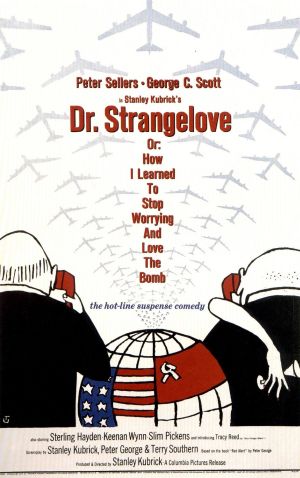Review by Dan Geddes
Peter Sellers … Group Capt. Lionel Mandrake / President Merkin Muffley / Dr. Strangelove
George C. Scott … Gen. ‘Buck’ Turgidson
Sterling Hayden … Brig. Gen. Jack Ripper
Keenan Wynn … Col. ‘Bat’ Guano
Slim Pickens … Maj. ‘King’ Kong
Peter Bull …Russian Ambassador Alexi de Sadesky
James Earl Jones …Lt. Lothar Zogg
Dr. Strangelove is a landmark movie satire. It so masterfully satirizes the military establishment and its doctrine of Mutually Assured Destruction (MAD) that it is surprising that it was produced and released at the height of the Cold War, shortly after the Cuban Missile Crisis and the Kennedy assassination.
The Strangelove theme is by now familiar: what if a crazy American general orders a first-strike attack on Russia on his own orders? And then there is no way to recall the mission despite (or even because of) the various safeguards? Isn’t it crazy for all of humanity to be living on such a hair-trigger alert?
Questioning the military establishment in a Hollywood movie was a pretty daring act for 1964. You wonder whether Kubrick and co-screenwriter Terry Southern were influenced more by the novel Catch-22 than by their acknowledged source, Red Alert, a serious thriller. Strangelove is full of Catch-22 absurdist moments: all of the war room scenes, the exchanges between mad General Jack D. Ripper (Sterling Hayden) and Captain Lionel Mandrake (Peter Sellers), and especially when Colonel Bat Guano (Keenan Wynn) is more concerned about damaging a Coke machine than about the runaway nuclear bomber. The system itself is shown to be crazy. The Russians have developed a “doomsday device” that will set off the destruction of all life on the surface of the earth if it detects that Russia has been attacked.
George C. Scott is solid as General Turgidson. He does extraordinary things with his facial expressions. He is not merely a buffoon; he represents America’s advanced strategic thinking of the time.
Peter Sellers is hilarious in his triple role: Captain Mandrake, as well as President Merkin Muffley, and Doctor Strangelove. His President Muffley is an uncanny representation of Adlai Stevenson. Although he is a bit petulant even as the earth rushes to destruction, he remains in command of the war room.
Sellers’ scenes as Doctor Strangelove are the most farcical, with his mechanical right arm that keeps breaking into Nazi salutes or even positions itself to strangle Strangelove. Strangelove’s mechanical arm suggests the future of a machine-controlled humanity, locked into nuclear wars because of automated procedures, and culminating in computerized control as seen in 2001: A Space Odyssey (1968) or in War Games (1983), a near re-telling of Strangelove. Depicting Doctor Strangelove as recruited talent from the Third Reich was also daring, as it suggests Operation Paperclip, the US effort to move top German technical talent to the US at the end of World War II.
The scenes from the bomber plane are the weak thread of the movie. Many scenes on the bomber plane are tedious shots of the aircrew flipping switches and going through their elaborate procedures. These scenes do feel “accurate,” but they are perhaps too belabored and slow down the movie without adding laughs or dramatic tension. True, the image of Slim Pickens riding the nuclear missile out of the bomber and shrieking a rodeo-style “Yee-ha!” remains iconic, for some almost the encapsulation of US foreign policy. However, I would have enjoyed more scenes in the war room.
Despite the superficial appearance of hi-tech sets such as the war room and the bomber cockpit, the sets are few and are relatively simple. The war room’s roundness and back-lit maps do all the work, while most of the set is dark. The shots of the bomber plan over Russia are clearly models.
While Strangelove is a movie landmark and everyone should see it, contemporary audiences may not find it laugh out loud funny, even if they see the point of the satire.
Dan Geddes
4 December 2011

